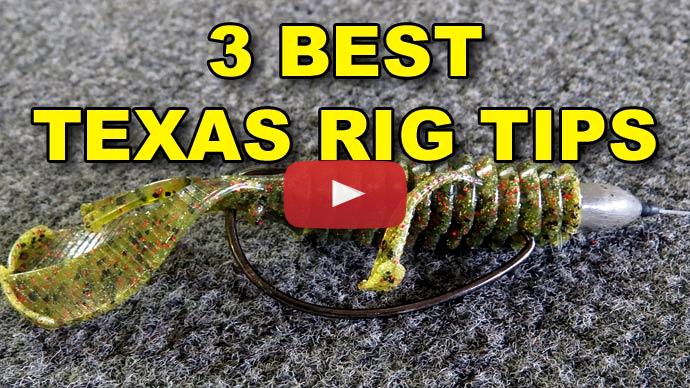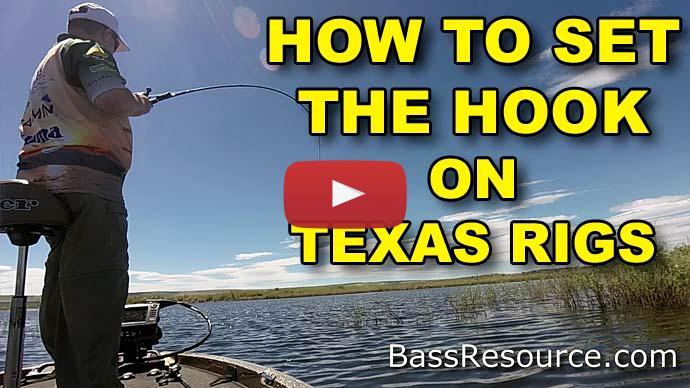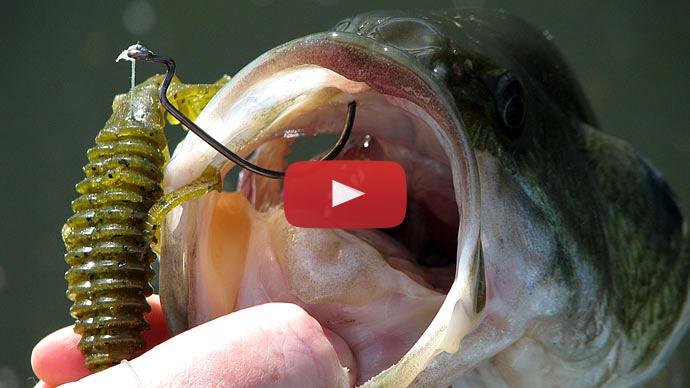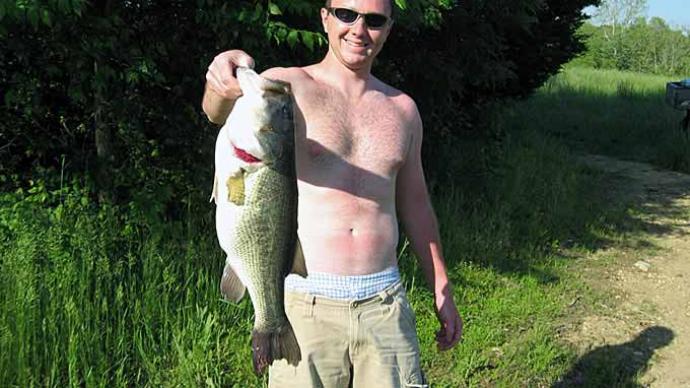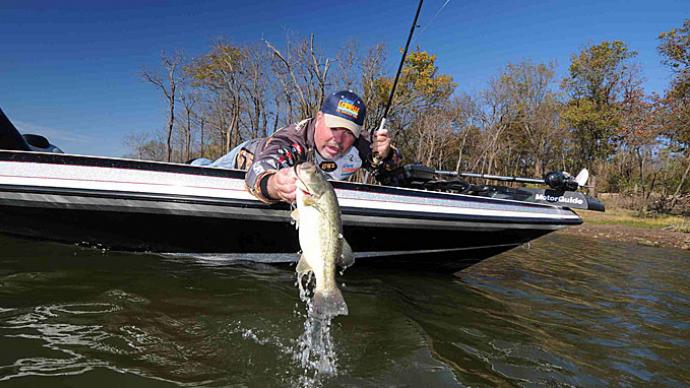Hey folks, Glenn May here with BassResource.com. And today I wanna talk to you about fishing plastic baits, fishing plastic worms, those type of things. Now if you've been fishing 'em for a while, you're bound to pick up a few tips from this video. And if you're new to fishing, if you wanna try out fishing plastic lures and baits, this video's definitely for you. What I wanna do is talk to you a little bit about the kind of equipment, the universal setup if you will, for fishing plastic lures, and then I'm gonna take you through some of the different techniques that have worked for all kinds of plastic baits.
So let's talk about equipment, starting with the rod. What I have here is a medium-heavy power, fast action tip rod. Seven foot. This is arguably, you know, the leatherman. This is the universal tool that you can use for fishing all kinds of baits. Matter of fact, I've got three or four rods like this in my rod locker right now, all rigged up with a couple of different baits. This is your standby. This is the... If you're starting out getting rods and reels, this is the one you wanna start with, really. It's a seven foot, medium-heavy power fast action rod.
Paired with it here is a, just your, you know, baitcasting reel. Anywhere, any time, you know... Any gear above 6.3:1 is really a good gear ratio. This one's about 7.1, I think it is. You want a good, strong drag system, and a smooth casting reel so that's easy to adjust, works just fine. You know, you don't have to go with the most expensive out there, but don't go cheap either, you just want a really good drag system. That's the most important thing, really nice, smooth drag system. That's key.
And then line, 15 pound line. I use copolymer line. Braid, I know a lotta people like braid, but braid isn't all that universal. It tends not to do as well in rocks. It can get frayed and dinged up in there, nicked. So what I like to do is use copolymer line. Fluorocarbon is great, it's also a bit expensive. We're looking for a universal setup that works in all kinds of conditions. I think copolymer works best for that. You can use fluorocarbon if you want, if your budget lets you do that, but I'm not getting fancy here, we're not using leaders or anything like that. It's just straightforward, easy fishing.
Tied onto that is your plastic bait. I've got... You can use a plastic worm, any kind of thing, anything you want that's made outta plastic. This happens to be the Rage Tail Rage Bug, one of my favorites. Absolutely love it. What I'm using here is a three-eighth ounce tungsten bullet sinker, tied on with a 3/0 hook. That is your universal setup. That's pegged with a bobber stopper right there, if you can see that. That's universal. You can swap this bait out and put just about any bait on there that's made outta plastic and you don't have to rerig everything, so that's...it's very versatile. That's what I like the most about this. So that's your setup, that's your rig.
Let's talk a little bit about how to fish these baits, any kinda plastic bait. The first and most easy one to do, is just cast it out there. Just cast it and let it sink. Flip the bail over, and what you wanna do is watch that line. And you wanna be in contact with it, so don't let it fall completely on slack line, but maintain contact with it. So semi-slack. Reel up some of the slack and feel it with your rod tip. A lotta times the bite will come, and you'll feel that through your rod tip, you'll feel that boink, right? You know, a bump, bump, right through your rod. But oftentimes the bite happens when you are just looking at the line. Watch where that line enters the water, and if you see it bump, twitch, go sideways, if it does something that you didn't do, odds are a fish did that, so you better set the hook.
The other thing I want you to do when you cast out like that is pay attention to how long it takes before it hits the bottom. Cast it out there, and if you have to, do some sorta countdown, some cadence. One, two, three, four, okay there, it hit the bottom, all right? So now I know about how deep it is there. And if you're going along fishing a shoreline, and every time you cast it's about a four count, five count, then one of your casts all of a sudden is one and it stops, a fish probably just opened his mouth and grabbed it and he's just sitting there, and you never felt a thing, but because you were paying attention to that fall, set the hook, okay? Swings are free. If you're not sure if it's a fish or not, set the hook.
And speaking of that, before I get to the couple other techniques here, when you set the hook, here's the deal. What a lotta people do, they do a feel game with the fish, right? They throw it out there, it falls, they're in contact with it, they're in the hook set position ready to go, and what they do is they're...they think there's a fish there, they feel something going on, and so they reel down, they're tightening on the line, they're feeling, and then they feel another tug, and they're like, "Okay, that's a fish," and then they set the hook, right?
That's not a very good hook set. If your line is already tight, what's gonna happen is the fish, he's got his mouth on it, okay, he's clamped down on it, and if your line's already tight, you've probably snugged up that..the bullet sinker right up to the inside of his mouth. So if you set the hook, what you're gonna do is turn his mouth around. You're gonna turn his head. The bait really isn't gonna move very far, if at all in his mouth, so the hook really isn't gonna set.
If this has ever happened to you, you're fishing a plastic bait, you're fishing the...fishing all the way back... Sorry, sorry, you set the hook, you're fighting the fish back, and all of a sudden, it comes loose. You're like, "What the heck." And you bring it all the way back and you look, and guess what? The hook hasn't even come out of the bait. Well that's what happened, okay? You set...you hit the sinker on the inside of his mouth and he never got his mouth open enough for that hook to penetrate.
So, here's what I want you to do when you set the hook. When you cast it out there, you're ready... First of all, the hook set position is you have it down here, but what happens, and I'll show you this when you're...in the next techniques, you're lifting up and if you feel a bite, reel down, but don't reel up tight. Reel down until you almost have it all the way tight, then set the hook, and set it hard, okay? What you're doing is you're throwing slack in the line, or if you've...say for instance you're feeling that game, you're doing that feel game, if you feel that, that’s tight, and you feel that fish, drop the rod tip, then set it. Throw some slack in it. Then what you're gonna do with that is your rod's gonna gain momentum, and speed, and power before it starts to move the bait in fish's mouth. Then when you do that, you're gonna piledrive that hook into his mouth.
If this bait is up against of...inside his lips, right inside his mouth, if you set it up that hard, this cone shape, it's actually gonna shoot through his mouth. It will have enough power to go through his mouth and then the hook will catch, and you'll get a good hook set. So always have a little bit of slack in your line before you set the hook. That's key. That's key to fishing these baits. You're gonna catch a lot more fish if you change your hook set that way.
All right, so let's talk about a couple other retrieves. So first thing you do is you cast it out there, let it sink, you're casting it to a bush, or a dock, or something, it hits the bottom. What you wanna do is let it sit for a second and just keep the line tight, and see if a fish comes and picks it up. And you can sit there for 5 seconds, 10 seconds, or a minute, it's up to you. But I usually let it sit for a couple seconds and if don't feel anything, then what I'll do is I'll reel down tight and I'll lift it up with the rod tip, and then I'll let it sink on semi-slack line. You can see I'm reeling it, but alls I'm doing is I'm reeling up the slack line as I bring the rod tip down. I'm not reeling the bait. Lift it up again to about the nine...10:00 position, and let it drop right back down.
If he doesn't hit in the first couple of bites, or first couple of pumps, then I reel it back in. Most of the time the bite happens as the bait is falling, so that technique works really well when the fish are active and they're hitting it when the bait is falling.
However, there's other techniques. If they don't wanna hit it while it's...while you're doing it that way, another technique is once it hits the bottom, you wanna scoot the bait along the bottom. Keep it on the bottom. Crawl it on the bottom. The way to do that, keep your rod tip down and don't move it with the reel, just move it with the rod tip. Just slowly move it with the rod tip. Now you reel up the slack as you bring your rod tip back. Now you're ready to bring it back again. Just slowly move it with the rod tip. Now you have slack in it, you reel up that slack as you bring your rod tip back. You're just crawling it along the bottom. Okay, that looks like a little bait fish, maybe a sculpin or a crawdad scurrying along the bottom. A lotta times the bass will chase it and they'll pick it up right off the bottom.
If you get that hooks...if you get that bite... Again, if you're all the way out here and you get that bite, reel up first, get that slack, and then set the hook. Don't try to hook set all the way back here. You're gonna bring it all the way back, and now you're like, you can't really set the hook, there's nothing left, you don't have any power. Okay, so... And that's the same thing whenever you cast, if you notice, I do it instinctively now, but a cast, first thing I do is I bring the rod tip down, I'm ready for the hook set position. Don't keep your rod up way up here, you have nothing left, there's nothing to hook set with. Keep it down here.
All right, so let's give you another technique. This what I like to do is, I like to bring the bait back, I like to swim it back a little bit. What I do is I just keep it right off the bottom and I'm slowly reeling it, keeping it just a few inches off the bottom. This works really well, especially if you're fishing, say, in hydrilla, or you're fishing it in milfoil. You wanna keep it right off the top of that, where the fish are buried in there, you'll entice them to come back out. So make a nice long cast, let it get down to it, and then alls you're gonna do is, you're gonna bring your rod tip up a little bit, and this varies, it depends on how deep the bait is and how deep the vegetation is. Sometimes you're gonna have your rod tip up here, but I like to keep it down as low as I can get away with and just slowly swim it, just slowly reel it over the top of the vegetation. And wait for that bite. Again, get ready for the hook set position, get ready to set that hook whenever that fish bites it, because boy you better be ready. Because when those fish hit it, you gotta slam it home. Because again, that hook point's texposed, it's buried a little bit in this bait.
Those are the basic retrieves that I use when I'm fishing plastic baits. For the most part, you can catch fish doing any of those retrieves, be it you’re fishing docks, you're fishing weeds, you're fishing submerged trees, whatever, it's the same different types of techniques, or same techniques for different types of baits, whether it's a Rage Bug like this, or you're fishing a plastic worm, or a lizard, or anything like that.
Anyway, I hope those tips helped. For more tips and tricks like this, and for the answers to all your questions about bass fishing, visit BassResource.com.

